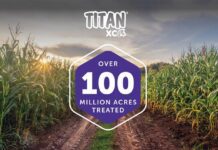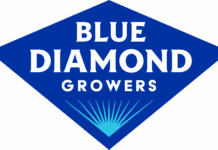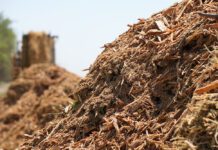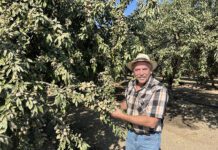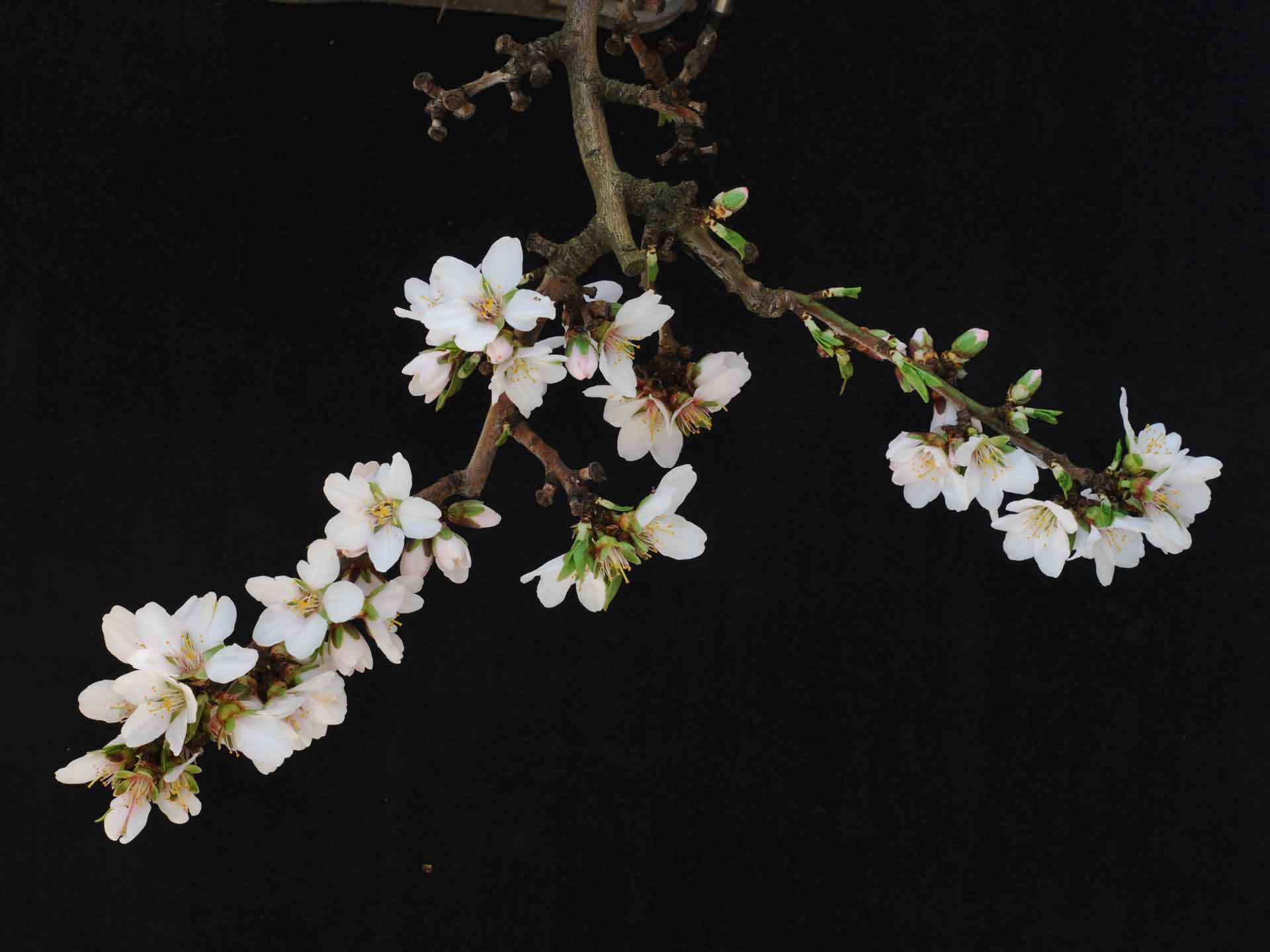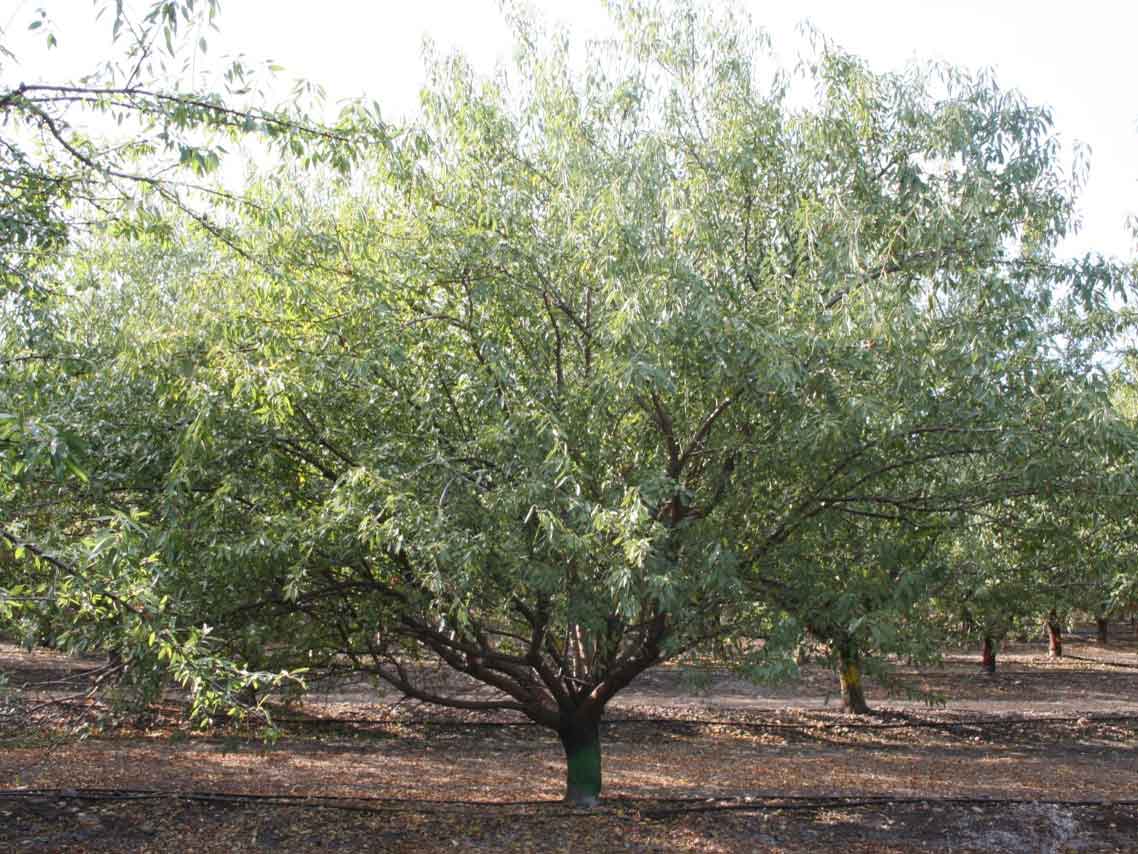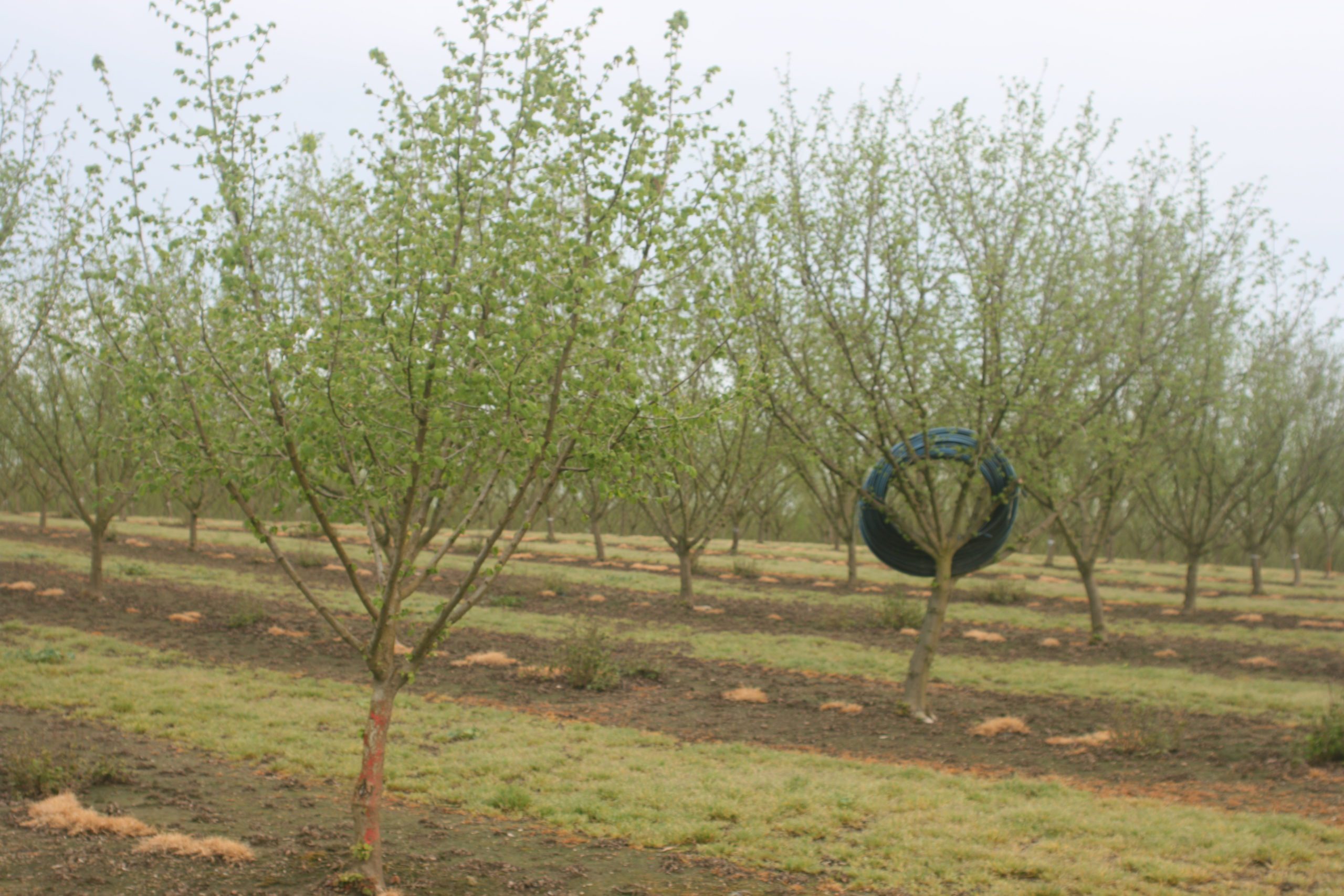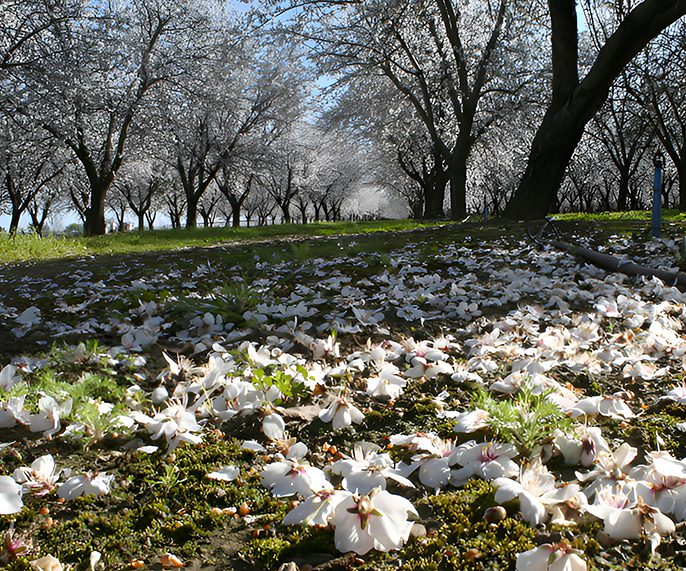
Listen to the audio version of this article. (Generated by A.I.)
Harvest may mark the end of the growing season, but it’s far from the end of orchard management. Postharvest is a critical time to set the stage for next year’s almond crop. Nutrition, irrigation and winter sanitation all play a vital role in maintaining tree health, minimizing pest pressure and improving long-term productivity. By focusing on these often-overlooked practices after the last nuts are shaken from the trees, growers can protect their investment and give their orchards a strong start for the coming season.
Fall Nutrients
Boron is a necessary nutrient, but it can be toxic at high levels. Jaime Ott, UCCE orchard systems advisor for Tehama, Shasta, Butte and Glenn counties, said the best way to sample for B is at harvest by collecting hull samples.
Ott recommends collecting hull samples because it tells if the orchard is deficient, but it also tells if it’s excessive, and too much or too little B can be problematic.
There are B deficiencies in the Sacramento Valley, particularly in the tougher soils on the west side.
The west side of the Sacramento Valley, covering parts of Colusa, Glenn, Yolo and western Tehama counties, has seen expanded almond plantings over the past two decades. While this region can produce high-quality almonds, nutrition, especially micronutrients like B, is a critical issue for these orchards.
Regardless of where almonds are grown, B is essential for almond productivity, particularly for:
• Flower development and pollination success
• Nut set and early fruit growth
• Cell wall formation and sugar transport
“With tougher soils, it’s just harder farming out there, so there’s stuff that we have to think about. Definitely people should be doing these hull boron tests,” Ott said.
When reviewing hull samples at harvest, the target range is 100 to 160 ppm.
“Orchards with hull boron levels less than 100 ppm will require an application of boron to the soil and application of foliar boron in the fall. The soil application should target 2 to 4 pounds of actual boron per acre and can be achieved by broadcasting approximately 25 to 50 pounds of borax, a boron fertigation, or a ground spray application of approximately 10 to 20 pounds of Solubor® (which, buffered, can be mixed in with an herbicide application). You want to avoid banding boron as this might result in it reaching toxic levels in certain areas,” Ott said.
“Orchards with hull boron levels less than 120 ppm will benefit from a fall [postharvest] foliar application of boron. As a rule of thumb, target 1 to 2 pounds of Solubor® per acre in 100 gallons per acre. This can be applied as a tank mix with zinc in the fall, though the pH will have to be adjusted to keep the zinc in solution,” Ott said, adding if B levels fall between 120 and 160 ppm, adding more B won’t improve orchard performance.
Orchards with hull B levels above 200 to 300 ppm may start to show signs of B toxicity, Ott continued. In cases of toxicity, soil and irrigation water should be tested for B levels and a B leaching plan should be considered.
A fall B spray can increase yield by hundreds of kernel pounds per acre when hull B analysis shows low to adequate orchard B, according to Franz Niederholzer, UCCE orchard systems advisor for Colusa and Sutter/Yuba counties.
“This yield bump has been documented in multiple studies by UC researchers. Recommended rates are 0.2 to 0.4 pounds boron per acre, equivalent to 1 to 2 pounds Solubor®, as a foliar spray applied at 100 gallons per acre spray volume targeting a full, healthy canopy. Lower rates of actual boron may not deliver the expected results. Higher rates of B per acre can reduce yield,” Niederholzer said, adding fall soil-applied B fertilizer doesn’t increase plant B levels until after petal fall the next year.
The key to effective fall B fertilization is getting it into the flowers by early bloom, Niederholzer continued. Fall B foliar applications increase pollen viability the following spring and increase nut set compared to trees with low B levels.
“Pink” bud bloom stage is also an effective timing for foliar B to improve almond yield, but when sprayed at full bloom it has been shown to actually reduce nut set. Since full bloom timing across an orchard can vary by variety, a fall spray at the right rate increases flower B with no risk to fruit set. For more information on B go to: https://www.sacvalleyorchards.com/almonds/horticulture/dont-neglect-your-B/
In terms of other nutrients, July leaf testing is recommended to determine where your trees stand. Leaf samples taken in early to mid-July can guide your nutrient application postharvest and next year.
“Nitrogen really should only be applied in season because the trees don’t take it up when they don’t have leaves,” Ott said. “In some cases, a postharvest nitrogen application can be helpful, but think of this as a catch-up application and not the optimal timing.”
For fall-applied nutrients, focus on Potassium and Zinc in the leaf samples. Growers have used Zn spray applications to defoliate the trees in the fall, and they called it zincing off the leaves, Ott said.
“I feel like people have moved away from that. But that does mean that we have some orchards that are zinc-deficient because they used to get this shot of zinc every fall, and they actually took up some of that zinc. The leaves did fall off from the zinc, but not before enough had been absorbed into the tree,” Ott said.

Fall Nutrient Checklist
As a fall checklist for nutrients, Ott suggests:
• Look at July leaf samples for Zn.
• Look at July leaf samples for K.
• Look at harvest hull samples for B.
“Potassium can be applied in-season as potassium thiosulfate, KTS, through a fertigation system, or a potassium nitrate foliar spray. However, many growers apply SOP or potassium sulfate to the soil, and you would want to do that in the fall before you get any winter rain because you need all that winter rain to help drive the potassium down into the root zone,” Ott said.
How much water? “You need enough water to push it down. So, the ideal is to put it on in the fall and hope we get enough winter rain to push it down. It’s not like a fungicide where it has to go on 12 hours before the rain,” Ott said.
K does tie up in the soil very easily. The least costly way to get it into trees is to band it and let the rain push it down, Ott said.
Signs of Nutrient Deficiency
“Severe nutrient deficiency tends to have pretty visible symptoms,” Ott said.
However, orchards in severe nutrient deficiency territory will lose yield before visible levels of symptoms appear.
“That’s why we really push the July leaf sample because that really tells you where you stand. You can say, okay, my July leaf sample is showing me that I’m about right in nitrogen but a little low in potassium. So that means that this coming up year, I should really make sure to meet those potassium needs that I didn’t quite meet,” Ott said.
With almond prices down, it’s possible growers may not be looking at nutrients as closely as they did in past years. Ott also works in walnuts and said, “A lot of walnut orchards probably haven’t seen fertilizer for the last three or four years.”
It wouldn’t surprise Ott that growers have backed off from applying nutrients. “I think you can really get good bang for your buck in terms of applying B. Making sure you have enough B is important, but not too much B. I really think that that’s worth it,” she said, adding Zn and K are important too, and the fall-applied nutrients really make a big difference in how strong the bloom and the nut set are the next year.
Ott thinks of these nutrients as the hidden heroes, but that doesn’t mean N isn’t crucial either. “I don’t want to understate how important nitrogen is, but I feel like people overfocus on nitrogen to the detriment of some of these other nutrients, and that loses them yield,” she said.
“I do think some of the harder soils, you’re balancing those nutrients a lot more carefully, and it’s a lot easier to get behind. In a lot of our west side soils, they’re basically growing those trees hydroponically, so you need to provide everything that tree needs in terms of water, in terms of nutrients, and if you’re not providing it, you’re not getting that bump from the soil,” Ott said.
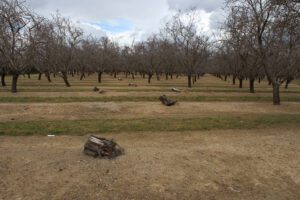
(all photos by K. Coatney.)
Postharvest Irrigation
Almond growers in California, especially in the early 2000s to mid-2010s, experimented with postharvest regulated deficit irrigation or even withholding irrigation entirely after harvest as a way to manage tree vigor, reduce hull rot risk and conserve water in dry years, but that’s no longer the case.
“We definitely want to get the water on after harvest as soon as possible,” Ott said, adding even turning on every other row to get water on the trees as soon after the nuts are picked up from the rows is very important.
Growers would still need to dry down the trees to shake them safely and at hull split, so that hull split happens quickly, Ott said, but as soon as possible after harvest get the water back on.
Fall Pests and Winter Sanitation
“Fall is a really good time, if you have the time and you’re not harvesting six other crops, to start planning what you’re doing in the dormant season. Late-fall or dormant-season aphid sprays are really an effective way to deal with aphids, far better than in-season,” Ott said.
Fall is also the time for winter sanitation. “We hammer, and I will continue to tell anybody who will listen, orchard sanitation for navel orangeworm (NOW) is your best friend and it is your most effective management tool against NOW,” Ott said.
“I’m kind of in the camp that if you do nothing else in the fall, sanitize your orchard,” Ott said.





